“Everything meaningful in my adult life has come from the relationship with this material,” says artist Michael David, referring to encaustic — a painting material composed of wax, damar varnish, and pigment. David will discuss his art and life as this year’s keynote speaker at the 15th International Encaustic Conference, organized by Truro Center for the Arts at Castle Hill.
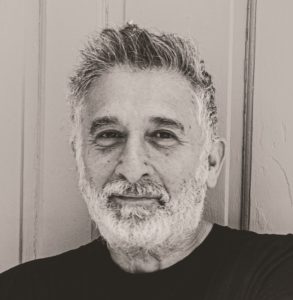
Known for its physicality and versatility, encaustic painting traces its beginnings to Fayum mummy portraits — surprisingly realistic paintings created in ancient Egypt — and extends to more contemporary examples such as Jasper Johns’s well-known encaustic paintings of targets and American flags. The conference, held at the Provincetown Inn from June 3 to 5, brings together over 150 artists to network and learn about the technique.
David has been working with six artists in a two-week residency at Castle Hill. He began using encaustic as a student at Parsons in the 1970s, a time when he also found inspiration in New York’s first-generation punk scene, occasionally playing bass for the early punk band the Plasmatics. Quoting Iggy Pop, David describes that time in New York as “dangerous, dirty, horrible, and amazing.”
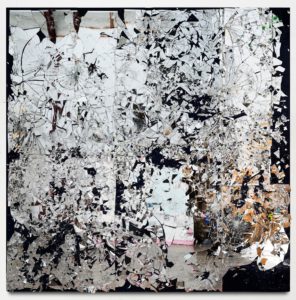
“I was young and very strong and fast and kind of aggressive and angry, and encaustic was so physical,” he says. “My experience with it was like being on stage. I could dig in, I could carve out, I could quote meaning, I could go back and forth. Oil painting was too slow for me.”
David was quickly noticed by the art world with his early symbol paintings created on wooden surfaces cut in the shapes of crosses, swastikas, and stars. The legacy of punk and abstract expressionism is evident in his work. These works also relate, however, to a discourse of minimalism — popular in 1970s New York — underscoring paintings as objects. His monochromatic symbol paintings are as simple as they are bombastic, which he likens to the “three chord” punk songs of the time.
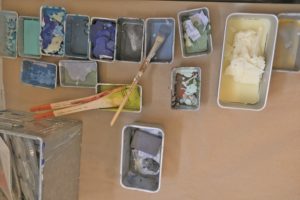
David was never a purist as a minimalist; rather, he moved toward narrative and juicy subject matter. “My abstraction was never purely abstract,” he says. “I was always aware of things that were going on around me socially. The crosses were about the history of Italian painting, Suprematism, Christianity, and kind of a punk statement — a hybrid of all those things.”
Eventually, he began to temper his provocative energy, abandoning the image of the swastika. “As a Jew, I knew there was a lot of charged history around it,” he says. “In some ways, I was doing it to cause controversy and to be seen and, ultimately, I decided that my responsibility was to not exploit it.”
Throughout his career, David returned to the symbol of the Golem, a creature in Jewish folklore, which, he says, “is this notion of when man puts himself in front of God and becomes too creative, he becomes self-destructive.” He had his own Golem experience in 1999 when he overheated wax, which should never be hotter than 180 degrees, and poured in damar varnish, creating a poisonous chemical reaction paralyzing him from the waist down. He still has only partial use of his legs. “I was so arrogant; no one could tell me to do anything,” he says of his disregard for safety. “I had made myself sick with the thing that I love to do the most.”
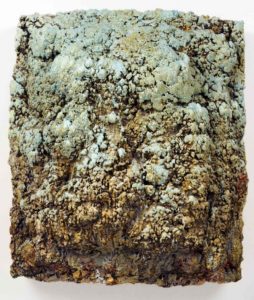
While recovering, David found solace in Buddhism and teaching. He moved to Atlanta and refocused his life. He began reading about “self compassion” and started making a series of “Chorten” paintings — mound-like objects referencing Buddhist monuments. The surface of these works appears as protruding diseased masses, encrusted with wax and pigment.
“When I was young, I was given so much and so wasn’t very mindful,” he says. “I didn’t believe I needed community at all.” When he began teaching in Atlanta, “this whole community formed around me.” More recently, during the pandemic, he started the online Yellow Chair Salon in partnership with Castle Hill.
David is now working via Castle Hill with participants both physically in Truro and streaming in on Zoom calls. “The collaborative wisdom of the group is very meaningful to me,” says Ellen Anthony of Truro, a current participant. The focus for Anthony has been less on producing work and more about “listening when nothing works.”
“All the work was inside,” Anthony says. David’s teaching focuses on personal reflection. “Look at yourself and why you’re making what you’re making and how it relates to you,” he says. “Most people are so worried about the formal aspect of it, they lose touch with themselves.”
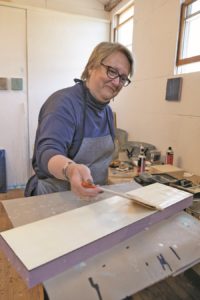
In the eaves of an old building on Castle Hill’s Edgewood Farm, Edith Beatty “gets lost in materiality,” she says. Her space smells of melted wax, and large swathes of handmade paper hang from the walls, dyed with natural materials such as walnut ink, turmeric, and red onion. One multi-panel piece recalls Asian art in its distilled simplicity: a single brush stroke of ink runs across a board encased in layers of encaustic. “I love the sense of translucence and depth” in encaustic, Beatty says.
Later in the day, the group gathers for a Zoom talk with Rosemarie Langry, an artist from central Ireland working in encaustic. Largely inspired by the colors and materiality of Irish bogs, Langry’s work reveals the versatility of encaustic. She uses its techniques to embed flowers in her work, layer over photographs, and coat wooden sculptures. The ensuing discussion opens pathways of conversation between participants in a way that’s productive for all the artists.
“When I’m not in the studio, my days are filled with other people who are working, and so it becomes this energy that goes back and forth,” says David. “It makes me check what I really believe.”
